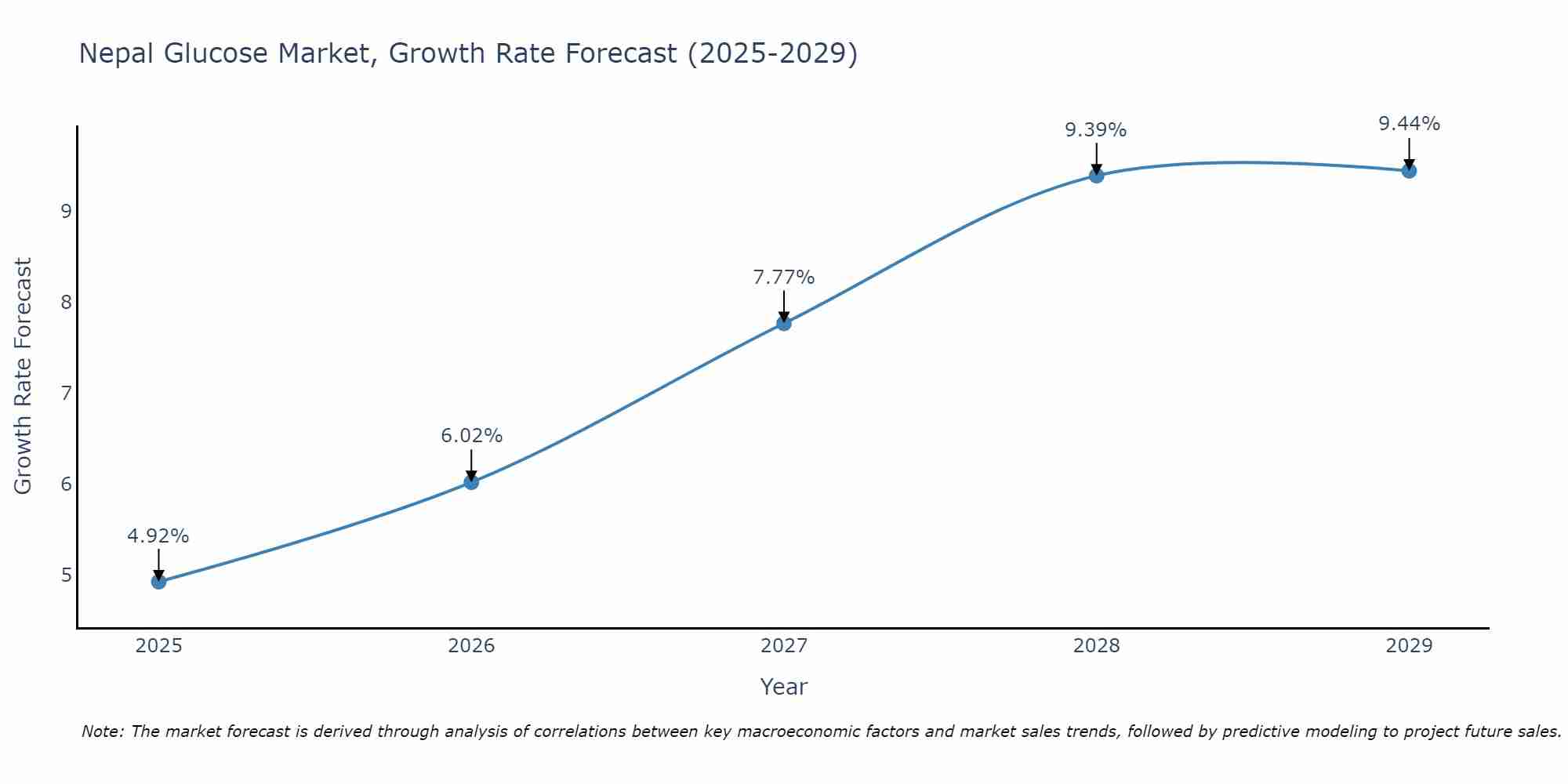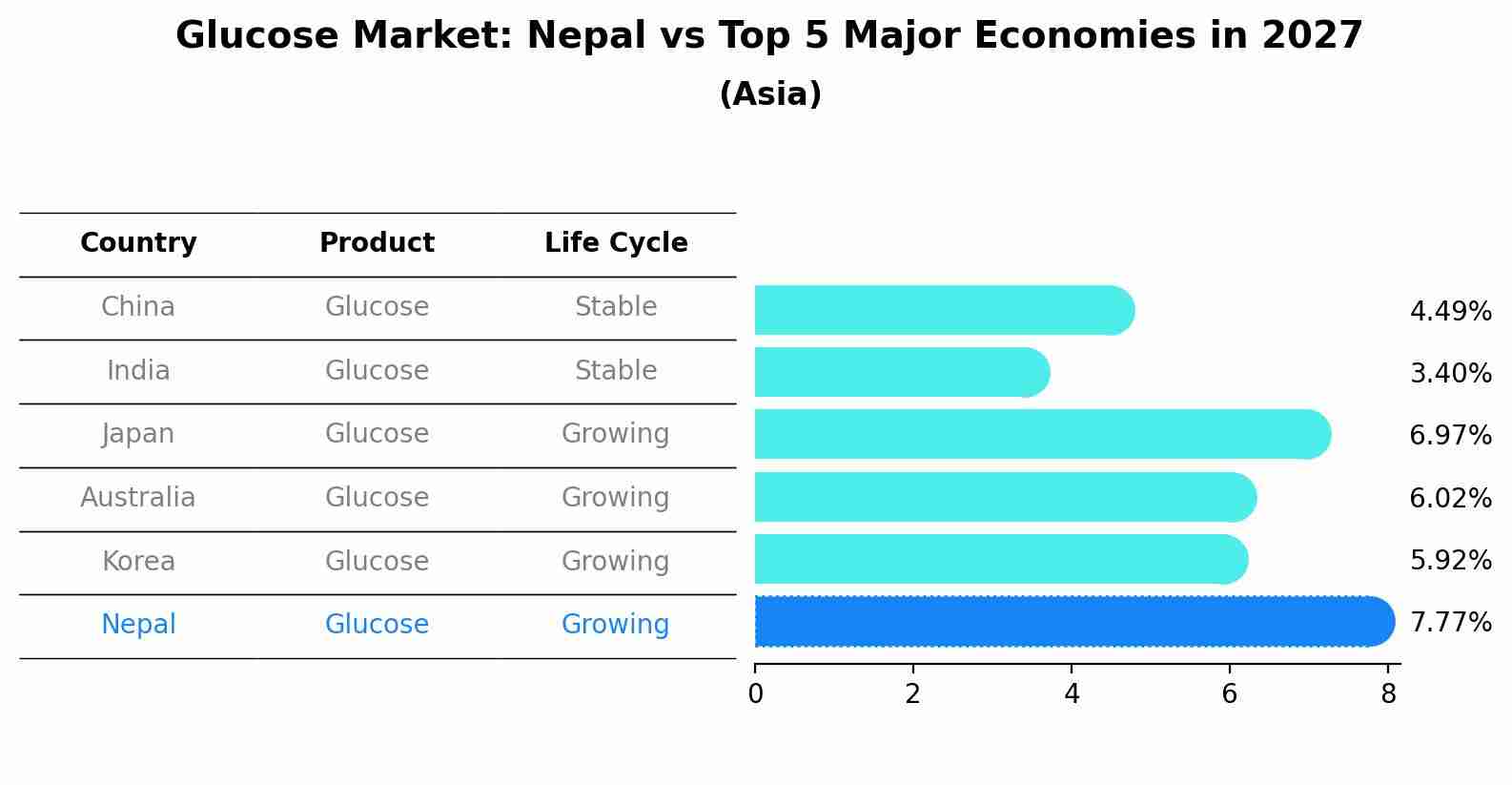Nepal Glucose Market (2025-2031) Outlook | Forecast, Size, Companies, Growth, Revenue, Industry, Value, Analysis, Trends & Share
| Product Code: ETC126032 | Publication Date: Jun 2021 | Updated Date: Jun 2025 | Product Type: Report | |
| Publisher: 6Wresearch | Author: Bhawna Singh | No. of Pages: 70 | No. of Figures: 35 | No. of Tables: 5 |
Nepal Glucose Market Size Growth Rate
The Nepal Glucose Market is poised for steady growth rate improvements from 2025 to 2029. From 4.92% in 2025, the growth rate steadily ascends to 9.44% in 2029.

Glucose Market: Nepal vs Top 5 Major Economies in 2027 (Asia)
Nepal's Glucose market is anticipated to experience a growing growth rate of 7.77% by 2027, reflecting trends observed in the largest economy China, followed by India, Japan, Australia and South Korea.

Nepal Glucose Market Overview
The Nepal glucose market is experiencing steady growth due to the increasing awareness about health and wellness among consumers. Glucose is a widely used product in Nepal for its quick energy-boosting properties, making it popular among athletes, students, and individuals with active lifestyles. The market is primarily dominated by local and regional brands offering glucose-based products in various forms like powder, tablets, and energy drinks. Key factors driving market growth include rising disposable incomes, changing dietary preferences, and the growing trend of health-conscious consumption. Additionally, the market is witnessing innovation in product formulations, packaging, and marketing strategies to cater to evolving consumer needs and preferences. Overall, the Nepal glucose market presents opportunities for both existing players and new entrants to capitalize on the increasing demand for energy-boosting products in the country.
Nepal Glucose Market Trends
In the Nepal Glucose Market, there is a growing trend towards health-conscious consumers seeking products that offer nutritional benefits and energy-boosting properties. Brands are focusing on promoting glucose products as quick and convenient sources of energy for busy lifestyles and sports activities. There is also an increasing demand for glucose products with natural ingredients, such as honey or fruit extracts, catering to the preferences of health-conscious consumers. Additionally, there is a rise in the availability of glucose products in various forms such as liquid, gel, and chewable tablets, offering consumers more choices and convenience. Overall, the market is witnessing a shift towards healthier and more diverse glucose products to meet the evolving needs and preferences of consumers in Nepal.
Nepal Glucose Market Challenges
In the Nepal Glucose Market, several challenges are faced, including intense competition among both domestic and international brands, fluctuating raw material prices, and changing consumer preferences. Due to the presence of numerous players offering similar products, companies must focus on innovation and effective marketing strategies to differentiate themselves and capture market share. Additionally, the volatility of raw material prices, such as sugar and wheat, can impact production costs and profit margins. Furthermore, consumer preferences are evolving, with a growing emphasis on healthier and natural alternatives to traditional glucose products, requiring companies to adapt and introduce new formulations to meet these demands. Overall, navigating these challenges requires market players to stay agile, continuously monitor market trends, and innovate to stay competitive in the Nepal Glucose Market.
Nepal Glucose Market Investment Opportunities
The Nepal Glucose Market presents promising investment opportunities due to the increasing demand for glucose products fueled by the growing health consciousness among consumers and the rising prevalence of lifestyle diseases such as diabetes. Investors can consider opportunities in manufacturing and distributing glucose-based products like energy drinks, sports drinks, glucose tablets, and glucose syrups. Furthermore, there is potential for innovation in the development of new and specialized glucose formulations to cater to specific consumer needs. Collaborating with health and fitness organizations to promote the benefits of glucose consumption could also be a strategic investment move in capturing a larger market share. Overall, the Nepal Glucose Market offers a fertile ground for investment with the potential for growth and profitability in the long term.
Nepal Glucose Market Government Policy
Government policies related to the Nepal Glucose Market include regulations on production, quality standards, and pricing. The government has implemented measures to ensure that glucose products meet specified quality criteria to safeguard consumer health. Additionally, there are regulations in place to control pricing to prevent price gouging and maintain affordability for consumers. The government also monitors production practices to ensure compliance with safety and hygiene standards. Import and export regulations may also impact the glucose market in Nepal, influencing availability and pricing of products. Overall, government policies play a significant role in shaping the operations and dynamics of the glucose market in Nepal by promoting consumer protection and fair competition among market players.
Nepal Glucose Market Future Outlook
The future outlook for the Nepal Glucose Market appears to be positive, driven by factors such as increasing consumer awareness about health and wellness, rising disposable incomes, and a growing focus on preventive healthcare. With a rising trend towards healthier lifestyles and dietary choices, the demand for glucose products is expected to continue to grow. Additionally, the popularity of energy-boosting products and the convenience of glucose as a quick source of energy are likely to further fuel market growth. The market may also witness innovations in product formulations and packaging to cater to evolving consumer preferences. Overall, the Nepal Glucose Market is poised for steady growth in the coming years, offering opportunities for both existing players and new entrants to capitalize on the expanding consumer base.
Key Highlights of the Report:
- Nepal Glucose Market Outlook
- Market Size of Nepal Glucose Market, 2021
- Forecast of Nepal Glucose Market, 2031
- Historical Data and Forecast of Nepal Glucose Revenues & Volume for the Period 2021 - 2031
- Nepal Glucose Market Trend Evolution
- Nepal Glucose Market Drivers and Challenges
- Nepal Glucose Price Trends
- Nepal Glucose Porter's Five Forces
- Nepal Glucose Industry Life Cycle
- Historical Data and Forecast of Nepal Glucose Market Revenues & Volume By Source for the Period 2021 - 2031
- Historical Data and Forecast of Nepal Glucose Market Revenues & Volume By Wheat for the Period 2021 - 2031
- Historical Data and Forecast of Nepal Glucose Market Revenues & Volume By Corn for the Period 2021 - 2031
- Historical Data and Forecast of Nepal Glucose Market Revenues & Volume By Others for the Period 2021 - 2031
- Historical Data and Forecast of Nepal Glucose Market Revenues & Volume By Type for the Period 2021 - 2031
- Historical Data and Forecast of Nepal Glucose Market Revenues & Volume By Food and Beverage for the Period 2021 - 2031
- Historical Data and Forecast of Nepal Glucose Market Revenues & Volume By Pharmaceuticals for the Period 2021 - 2031
- Historical Data and Forecast of Nepal Glucose Market Revenues & Volume By Others for the Period 2021 - 2031
- Nepal Glucose Import Export Trade Statistics
- Market Opportunity Assessment By Source
- Market Opportunity Assessment By Type
- Nepal Glucose Top Companies Market Share
- Nepal Glucose Competitive Benchmarking By Technical and Operational Parameters
- Nepal Glucose Company Profiles
- Nepal Glucose Key Strategic Recommendations
Frequently Asked Questions About the Market Study (FAQs):
Nepal Glucose |
1 Executive Summary |
2 Introduction |
2.1 Key Highlights of the Report |
2.2 Report Description |
2.3 Market Scope & Segmentation |
2.4 Research Methodology |
2.5 Assumptions |
3 Nepal Glucose Market Overview |
3.1 Nepal Country Macro Economic Indicators |
3.2 Nepal Glucose Market Revenues & Volume, 2021 & 2031F |
3.3 Nepal Glucose Market - Industry Life Cycle |
3.4 Nepal Glucose Market - Porter's Five Forces |
3.5 Nepal Glucose Market Revenues & Volume Share, By Source, 2021 & 2031F |
3.6 Nepal Glucose Market Revenues & Volume Share, By Type, 2021 & 2031F |
4 Nepal Glucose Market Dynamics |
4.1 Impact Analysis |
4.2 Market Drivers |
4.3 Market Restraints |
5 Nepal Glucose Market Trends |
6 Nepal Glucose Market, By Types |
6.1 Nepal Glucose Market, By Source |
6.1.1 Overview and Analysis |
6.1.2 Nepal Glucose Market Revenues & Volume, By Source, 2018 - 2027F |
6.1.3 Nepal Glucose Market Revenues & Volume, By Wheat, 2018 - 2027F |
6.1.4 Nepal Glucose Market Revenues & Volume, By Corn, 2018 - 2027F |
6.1.5 Nepal Glucose Market Revenues & Volume, By Others, 2018 - 2027F |
6.2 Nepal Glucose Market, By Type |
6.2.1 Overview and Analysis |
6.2.2 Nepal Glucose Market Revenues & Volume, By Food and Beverage, 2018 - 2027F |
6.2.3 Nepal Glucose Market Revenues & Volume, By Pharmaceuticals, 2018 - 2027F |
6.2.4 Nepal Glucose Market Revenues & Volume, By Others, 2018 - 2027F |
7 Nepal Glucose Market Import-Export Trade Statistics |
7.1 Nepal Glucose Market Export to Major Countries |
7.2 Nepal Glucose Market Imports from Major Countries |
8 Nepal Glucose Market Key Performance Indicators |
9 Nepal Glucose Market - Opportunity Assessment |
9.1 Nepal Glucose Market Opportunity Assessment, By Source, 2021 & 2031F |
9.2 Nepal Glucose Market Opportunity Assessment, By Type, 2021 & 2031F |
10 Nepal Glucose Market - Competitive Landscape |
10.1 Nepal Glucose Market Revenue Share, By Companies, 2021 |
10.2 Nepal Glucose Market Competitive Benchmarking, By Operating and Technical Parameters |
11 Company Profiles |
12 Recommendations |
13 Disclaimer |
- Single User License$ 1,995
- Department License$ 2,400
- Site License$ 3,120
- Global License$ 3,795
Search
Related Reports
- Portugal Occupational Health & Safety Services Market (2025-2031) | Strategy, Consumer Insights, Analysis, Investment Trends, Opportunities, Growth, Size, Share, Industry, Revenue, Segments, Value, Segmentation, Supply, Forecast, Restraints, Outlook, Competition, Drivers, Trends, Demand, Pricing Analysis, Competitive, Strategic Insights, Companies, Challenges
- Netherlands Occupational Health and Safety Services Market (2025-2031) | Strategy, Consumer Insights, Analysis, Investment Trends, Opportunities, Growth, Size, Share, Industry, Revenue, Segments, Value, Segmentation, Supply, Forecast, Restraints, Outlook, Competition, Drivers, Trends, Demand, Pricing Analysis, Competitive, Strategic Insights, Companies, Challenges
- Belgium and Luxembourg Facility Management Market (2025-2031) | Strategy, Consumer Insights, Analysis, Investment Trends, Opportunities, Growth, Size, Share, Industry, Revenue, Segments, Value, Segmentation, Supply, Forecast, Restraints, Outlook, Competition, Drivers, Trends, Demand, Pricing Analysis, Competitive, Strategic Insights, Companies, Challenges
- Russia Women Intimate Apparel Market (2025-2031) | Strategy, Consumer Insights, Analysis, Investment Trends, Opportunities, Growth, Size, Share, Industry, Revenue, Segments, Value, Segmentation, Supply, Forecast, Restraints, Outlook, Competition, Drivers, Trends, Demand, Pricing Analysis, Competitive, Strategic Insights, Companies, Challenges
- Africa Chocolate Market (2025-2031) | Size, Share, Trends, Growth, Revenue, Analysis, Forecast, industry & Outlook
- Global Hydroxychloroquine And Chloroquine Market (2025-2031) | Industry, Trends, Size, Outlook, Growth, Value, Companies, Revenue, Analysis, Share, Forecast
- Saudi Arabia Plant Maintenance Market (2025-2031) | Industry, Size, Growth, Revenue, Value, Companies, Forecast, Analysis, Share & Trends
- Taiwan Electric Truck Market (2025-2031) | Outlook, Industry, Revenue, Size, Forecast, Growth, Analysis, Share, Companies, Value & Trends
- South Korea Electric Bus Market (2025-2031) | Outlook, Industry, Companies, Analysis, Size, Revenue, Value, Forecast, Trends, Growth & Share
- Africa Low Temperature Powder Coating Market (2025-2031) | Companies, Competition, Size, Challenges, Segmentation, Trends, Competitive, Industry, Supply, Strategy, Investment Trends, Growth, Segments, Restraints, Strategic Insights, Revenue, Share, Forecast, Drivers, Analysis, Pricing Analysis, Demand, Consumer Insights, Value, Opportunities, Outlook
Industry Events and Analyst Meet
Our Clients
Whitepaper
- Middle East & Africa Commercial Security Market Click here to view more.
- Middle East & Africa Fire Safety Systems & Equipment Market Click here to view more.
- GCC Drone Market Click here to view more.
- Middle East Lighting Fixture Market Click here to view more.
- GCC Physical & Perimeter Security Market Click here to view more.
6WResearch In News
- Doha a strategic location for EV manufacturing hub: IPA Qatar
- Demand for luxury TVs surging in the GCC, says Samsung
- Empowering Growth: The Thriving Journey of Bangladesh’s Cable Industry
- Demand for luxury TVs surging in the GCC, says Samsung
- Video call with a traditional healer? Once unthinkable, it’s now common in South Africa
- Intelligent Buildings To Smooth GCC’s Path To Net Zero













